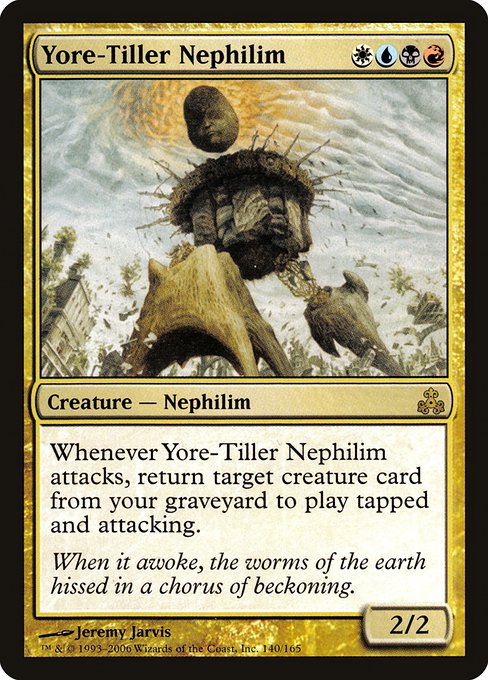
Image courtesy of Scryfall.com
Constraint Sparks Better Yore-Tiller Nephilim Deckbuilding
There’s a certain music to deckbuilding when you lean into constraints instead of trying to break every rule at once. Yore-Tiller Nephilim, a rare from Guildpact released in 2006, is a perfect muse for that mindset. With a mana cost of {W}{U}{B}{R}, this four-color powerhouse defies the convenience of a single-color strategy and invites you to craft a plan that respects balance even as it pushes the envelope. Its creature type—Nephilim—hints at a mosaic of influences, and its on-attack trigger rewards players who lean into proactive, combat-centric plays. When you plan a deck around this card, you’re not chasing raw power alone; you’re choreographing an insurance policy of value that blooms the moment you swing. 🧙🔥
The four-color identity as a design constraint
Four colors on a single card is a bold design statement, and Yore-Tiller Nephilim wears it as a badge of identity. The color identity (B, R, U, W) signals a broad palette for fixing, disruption, removal, card draw, and value engines. This constraint—not to mention the card’s attack-triggered recursion—nudges you toward a carefully curated mana base. You’ll naturally consider multi-color fetchers and duals, or you’ll craft a splash-heavy mana base that minimizes color-screw risk in opening turns. The result isn’t chaos; it’s a disciplined exploration of what your graveyard can offer once you commit to a plan that’s big, bold, and a little bit reckless in the best way. ⚔️
Practical constraints that sharpen deckbuilding in practice
- Define a clear endgame: with Nephilim, the endgame often revolves around turning your graveyard into ongoing pressure. Decide early whether you want a toolbox approach (returning different types of creatures to the battlefield) or a focused loop with one or two key targets. 🧭
- Limit your color spikes: pick two or three colors you can reliably support with mana sources and a handful of resilient threats. The four-color reality pushes you to value mitigation—think about countermagic, bounce, and targeted removal that covers multiple threats. 💎
- Pack dependable graveyard interactions: since the ability reloads your battlefield when Yore-Tiller Nephilim attacks, you want graveyard-recovery options that you can rely on across games. Reanimation effects, controlled draws, and graveyard hate for opponents should be balanced so you’re not light on gas in later turns. 🧙🔥
- Build around inevitability, not just speed: the Nephilim’s attack-triggered reanimation can turn a stalemate into a race, but you’ll want to ensure you’re not giving your opponent a way to outpace your plan. Repeatable value, not just big haymakers, keeps the deck resilient. ⚔️
- Stabilize your mana base: with four colors, you’ll lean on lands or mana rocks that smooth your early turns. The goal is to reach a steady rhythm where you can cast your spells on time and still trigger the Nephilim’s payoff on the attack. 🎲
Strategic play patterns that emerge from constraint
When you embrace a constraint-driven approach, you’ll notice several recurring patterns. First is the cadence of attack: you plan a sequence where Yore-Tiller Nephilim swings, reanimates a creature from your graveyard, and pushes the board position with improved threats on the next combat. The pressure compounds as you sequence your plays—swing, recur, swing again, repeat. This rhythm makes you value vigilance over pure aggression; you’ll favor removal that protects your plan and answers that keep your graveyard options open. 🧙♂️
Second comes the elegance of the toolbox: you don’t need a mountain of individual effects. A few solid recursors, a couple of tutors or draw-disruption spells, and a handful of flexible answers create a deck that’s coherent yet powerful. The constraint forces you to pick well rather than spread thin, and the payoff is a deck that can outgrind even more linear archetypes. The art of constraining your choices often yields a deck that feels crafted, not improvised. 🎨
Flavor, lore, and card design intuition
Yore-Tiller Nephilim’s flavor text—“When it awoke, the worms of the earth hissed in a chorus of beckoning.”—echoes a theme of lineage, emergence, and the inexorable pull of the graveyard into combat. It’s a reminder that in MTG, every card is a story seed: the idea that memory and matter collide on the battlefield. The Nephilim’s four-color identity mirrors a world where multiple cultures and forces collide, producing a synthesis that’s potent in the right hands. That blending of lore and mechanics is why constraint-driven deckbuilding feels so satisfying: it’s not just about power; it’s about telling a winning story with chosen limitations. 🧙🔥💎
When it awoke, the worms of the earth hissed in a chorus of beckoning.
Art, archetype, and community resonance
Jeremy Jarvis’s evocative art anchors this card in a moment of ominous, otherworldly presence. The Guildpact era is a reminder of a time when color-minted mechanics nudged players to think about identity seriously, and Nephilim’s presence invites experimental four-color lists that still feel true to formats like Modern or Commander where legal. Collectors and casual players alike appreciate the card for the story it tells, the power it hints at in the right shell, and the art that captures the tension between awakening and warfare. If you’re building with constraint as your compass, cards like this become a beacon for creative prototypes and homebrew innovations. 🎨🧩
For fans who want to dip their toes into constrained deckbuilding with a four-color centerpiece, the journey is as rewarding as the destination. You’ll learn to value redundancy, plan for your graveyard’s next move, and enjoy the mental puzzle of keeping four colors coherent in a competitive game. The payoff isn’t just a win—it’s the satisfaction of a well-constructed plan that felt almost inevitable once the constraints clicked into place. 🧠⚔️